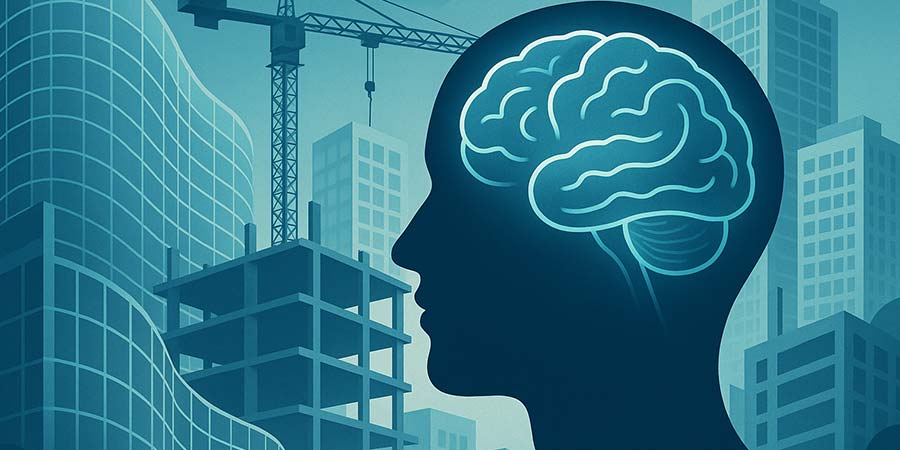
Does neuroarchitecture sound familiar? If not, then have you ever entered a room and felt an instant change in your mood? This spontaneous reaction is at the core of neuroarchitecture. To put it simply, it is an interesting discipline that combines neuroscience with architectural design. The result is spaces that give a positive vibe and uplift our mood, health, and productivity.
Neuroarchitecture is essentially the science-backed fusion of neuroscience and architectural design. This developing concept exploits evidence from brain research and provides insights into spatial planning, acoustics, lighting, layout, and materiality. The objective is to enrich emotional well-being, cognitive performance, and productivity.
For AEC businesses operating in the U.S., incorporating this awareness is far more than just a trend. Honestly, it is a strategic asset in the current fast-paced world. This article will delve into the principles of neuroarchitecture, along with its significance in the AEC industry and practical strategies to implement it.
What Truly Neuroarchitecture Is All About
When brain science is applied to design, it is known as neuroarchitecture. Essentially, it depends on emotional and cognitive responses to different design aspects, such as:
- Natural light that regulates circadian rhythms
- Color tones that impact calmness, focus, or motivation
- Acoustic harmony to support conversation or quiet concentration
- Spatial volume and circulation affect wayfinding, movement, and comfort
Robust research efforts in neuroscience and environmental psychology indicate that these aspects can influence stress, cognitive function, creativity, and the overall wellness of humans. For instance, being exposed to natural light in workplaces has been associated with a 15% increase in productivity while reducing cortisol levels.
The Science Behind Neuroarchitecture
First of all, it is essential to understand that the human brain constantly tries to decode the surroundings – light, color, form, sound, temperature, and air. All these elements can stimulate diverse neurological responses. In particular:
- Natural views and curved shapes can boost calmness and creativity. A VR-based study has revealed that curved environments can lead to higher creativity levels and reduced stress. It also considerably diminishes heart rate, making individuals calmer.
- Ceiling height promotes creative thinking ability. Higher ceilings can nurture creative and abstract thought, while lower ceilings can enhance focus.
- Natural daylight potentially controls circadian rhythms, which enhance awareness during the day and the restful quality of the night.
In conjunction, these observations actually challenge engineers and architects to design spaces that brain research validates.
Core Principles
Integration of Biophilia and Nature
Plants, living walls, water features, and views of greenery are known to lower cortisol levels, blood pressure, and stress. This is true in every type of space. For example:
- In hospitals, patients with natural surroundings recover faster and require less pain medication than those in rooms with simple walls.
- In workplaces like Amazon’s Sphere in Seattle, the existence of thousands of plants has led to reduced stress and elevated levels of creativity among workers.
Optimized Circadian and Natural Lighting
Modern building designs include window positioning strategies, daylight sensors, and daylight-redirecting devices. The objective of these elements is to modulate the intensity of light and color throughout the day. A VR study suggests that diverse lighting can drastically improve cognitive performance, including memory and visual processing.
Acoustic Zoning and Quiet Computing
Quietness is essential to remain focused. Noise levels exceeding 41 decibels in classroom environments can negatively impact examination performance. This is the reason there is a surge of acoustic dividers, sound-masking techniques, and quiet pods in modern workspaces. These tactics are now known as quiet computing and are widely welcomed in hybrid work environments.
Spatial Configuration and Flow
Open and intuitive layouts often curtail stress and cognitive pressure with wayfinding cues and transparent sightlines. It has been observed that a logical flow from reception to workstations, lucid zoning, and transition spaces like atriums enable psychological ease.
Texture, Material, and Color Psychology
Natural elements like wood and stone can contribute to subconscious comfort. On the contrary, reflective surfaces or sharp angles have been reported to trigger stress responses. Additionally, colors play a pivotal role. For instance, soft greens and blues evoke a sense of calmness, while warm tones foster creativity. The color temperature of lighting influences different moods and can adapt spaces to particular tasks.
Importance of Neuroarchitecture for AEC Firms
In the AEC sector of the United States, project delivery relies on cost efficiency, client satisfaction, and compliance. This is precisely where neuroarchitecture can function as a multidisciplinary value addition.
- Data-Centric Design
Neuroarchitecture can help quantify wellness benefits with factors like better patient recovery rates, reduced absenteeism, and student grades. - Market Differentiator
AEC firms can pitch a better occupant experience to owners, developers, and corporate clients. - Sustainability Integration
Optimization of natural lighting can facilitate lowering energy use and support green building certifications like WELL and LEED. - Better Satisfaction
Both decision-making stakeholders and end-users experience enhanced value from spaces that are comfortable and thoughtfully designed.
By allowing neuroscience to weave into the design procedure, AEC businesses not only adhere to regulations but also influence lasting client loyalty.
Incorporating Neuroarchitecture in Projects
Setting Behavioral Goals
The very first step to applying neuroarchitecture in AEC projects involves establishing behavioral goals. It is crucial to define clear objectives, like reducing stress levels, boosting creativity, or encouraging collaboration. Establishing specific goals enables the selection of particular design features, such as daylight controls or acoustic barriers.
Simulate and Model
The second step comprises using VR simulations and performance modeling. They allow for evaluating features such as spatial layouts, acoustics, lighting, sightlines, material textures, and comfort. Assessing all these aspects should be done before actual construction work begins.
Integrated BIM-Powered Coordination
Concerning the AEC industry, neuroarchitecture needs interdisciplinary collaboration among structure, architecture, MEP, lighting, acoustics, and interiors. By utilizing BIM platforms, AEC firms can make sure that air flows, light shafts, sound zones, and structural aspects are comprehensively resolved.
Prototype and Test
Prototype models or scaled versions enable stakeholders to experience acoustics, lighting, sightlines, and layout before deciding on the final design.
Feedback and Post-Occupancy Evaluation
In order to refine and enhance designs for any future projects, occupant surveys and sensors collect information on performance, well-being, air quality, and stress. This information is also used to understand whether the space aligns with the design intent.
How UPPTEAM Can Support Your Neuroarchitecture Goals
UPPTEAM’s specialization is in scalable BIM modeling, along with expertise in sustainable design documentation and collaborative architecture-MEP workflows. These proficiencies are well-placed for supporting neuroarchitecture-centric projects. Our team can support you with the following:
- Comprehensive Modeling
We can develop simulation-ready models with embedded HVAC, light, and acoustic attributes for performance verification. - Coordinated Systems
Our BIM-powered clash detection expertise guarantees that comfort systems do not compromise design intent. - Documentation Assistance
Our crafted drawings resonate with spatial logic – acoustics, lighting, material – to streamline contractor clarity and approvals. - POE Support
We provide sensor-based modeling and documentation delivery for client assessment and workflow refinement.
Moreover, with extensive proficiency in diverse building types, our services related to BIM coordination and drafting can integrate acoustic, thermal, visual, and comfort metrics – helping a project’s neuroarchitecture objectives.
To Sum Up
So, one thing is sure: neuroarchitecture invites AEC firms to work with the most critical occupant of all, the human brain. It can transform buildings and spaces from structures into well-being enablers.
Through the integration of neuroarchitecture’s core principles, AEC businesses can deliver spaces that boost emotional function, social connections, and healing capability. With UPPTEAM’s multidisciplinary-aligned MEP and BIM expertise, your upcoming project can comprehensively nurture those principles. The outcome will be spaces that look remarkable and feel right while improving creativity and productivity.
Partner with UPPTEAM to construct buildings with brain-led design at their core. We help neuroscience and architecture meet their true purpose.


















